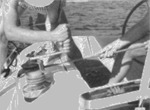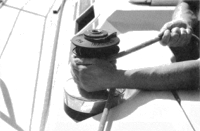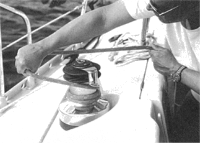Winch Use & Safety
The proper way to ease a line on a winch.
 When the jib sheet is eased to adjust for a slight course or wind change, place one hand over the coils on the drum with your thumb touching your index finger - not sticking out where it can get caught in a loop. Your fingers should be pointing clockwise (looking down from above). Ease the end of the line with the other hand. The hand on the coils controls the speed with which the sheet is eased. Without it, the coils can stick on the drum while the sheet is being eased at the free end and suddenly jerk out, catching you by surprise and possibly pulling your easing hand into the coils around the winch.
When the jib sheet is eased to adjust for a slight course or wind change, place one hand over the coils on the drum with your thumb touching your index finger - not sticking out where it can get caught in a loop. Your fingers should be pointing clockwise (looking down from above). Ease the end of the line with the other hand. The hand on the coils controls the speed with which the sheet is eased. Without it, the coils can stick on the drum while the sheet is being eased at the free end and suddenly jerk out, catching you by surprise and possibly pulling your easing hand into the coils around the winch.
The proper way to get extra wraps around the drum of a winch. Before a tack or jibe, the lazy side winch should have one or two wraps on it to prepare for the maneuver (always wrap the winch clockwise.) When it's time to tack or jibe, be aware of the tension on the working sheet before you uncleat it and hold tight. When the tack or jibe is commenced, release the working side, remove the wraps, and pull in on the new sheet. As soon as there is some pressure, add wraps to avoid losing what was taken in. There is one fast and safe way of doing this. Take the line in one hand and pass it around the winch two or three times allowing the line to ease through your hands as it goes.
Before a tack or jibe, the lazy side winch should have one or two wraps on it to prepare for the maneuver (always wrap the winch clockwise.) When it's time to tack or jibe, be aware of the tension on the working sheet before you uncleat it and hold tight. When the tack or jibe is commenced, release the working side, remove the wraps, and pull in on the new sheet. As soon as there is some pressure, add wraps to avoid losing what was taken in. There is one fast and safe way of doing this. Take the line in one hand and pass it around the winch two or three times allowing the line to ease through your hands as it goes.
Don't ease enough to let the line slip on the drum - just enough to accommodate the extra wraps around the winch. The other hand is used only to feed line to the hand putting the wraps around the winch. I've seen sailors hold onto the line leading from the winch with one hand and make an extra wrap with the other. The result is they are wrapping the former hand into the winch coils. If they don't get it out quickly or if the sheet slips out of the drum, that hand can get caught.
If there's enough crew, it's faster if one person tails. the other cranks using both hands with shoulders right over the winch. After sufficient wraps have been taken and the crew member can no longer take in any slack by hand due to the force of the wind in the sail, another crew inserts a winch handle and cranks the sheet in while the first tails (pulls tension on the slack end of the sheet) Self-tailing winches eliminate the need to tail the sheet.
After sufficient wraps have been taken and the crew member can no longer take in any slack by hand due to the force of the wind in the sail, another crew inserts a winch handle and cranks the sheet in while the first tails (pulls tension on the slack end of the sheet) Self-tailing winches eliminate the need to tail the sheet.
By standing with shoulders over the winch and feet spread for balance, you have better leverage for turning the handle and trimming the sail. The jib sheets should be coiled and laid down in the cockpit so the coil runs off the top in the event a quick tack or jibe is necessary.
Steve Colgate is the founder of Colgate Sailing Schools, with locations in Tortola BVI, Captiva Island FL, Duck Key FL, St. Petersburg FL, Chelsea Piers NY, Liberty Landing NJU and Newport RI.
Offshore Sailing Schools
16731 McGregor Blvd.
Fort Myers, Florida 33908
1-888-454-8002
239-454-1700
Fax: 239-454-1191
e-mail: [email protected]
www.offshore-sailing.com












